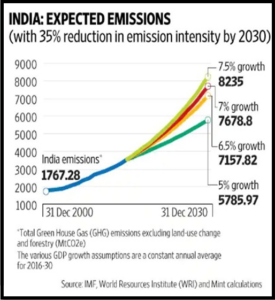INDIA’S EMISSION ACHIEVEMENTS: DECOUPLING GROWTH FROM EMISSIONS
India successfully reduced its GDP emission intensity by 33% between 2005 and 2019.
This achievement was realized 11 years ahead of the set target.
Source : The Indian Wire
About GDP Emission Intensity
- GDP emission intensity measures the amount of greenhouse gas emissions produced per unit of Gross Domestic Product (GDP).
- It reflects the efficiency with which a country’s economic activities generate emissions, indicating the extent to which economic growth is associated with environmental impact, with lower intensity values signifying greener economic practices.
Economic Growth vs. Emissions:
- Despite a cumulative annual GDP growth rate of 7%, emissions only rose by 4% per year.
- India showcases effective decoupling of economic growth from greenhouse gas emissions.
National Communication Report:
- ‘The Third National Communication to the UN Framework Convention on Climate Change’ highlights India’s emission reduction achievements.
- The report, presented at COP-28 in Dubai, emphasizes the creation of an additional carbon sink of 1.97 billion tonnes of CO2 equivalent.
Future Targets and NDCs:
- India remains committed to further reductions, aiming for a 45% decrease in GDP emission intensity by 2030.
- The nation also aims to create an additional carbon sink of 2.5 to 3.0 billion tonnes through tree and forest cover by 2030.
- Prime Minister Narendra Modi proposes to host COP33 in 2028, emphasizing India’s leadership and achievements in climate goals.
India’s proactive measures demonstrate a significant stride towards sustainable development and climate leadership, setting an example for global climate action.

 Source : The Indian Wire
Source : The Indian Wire

